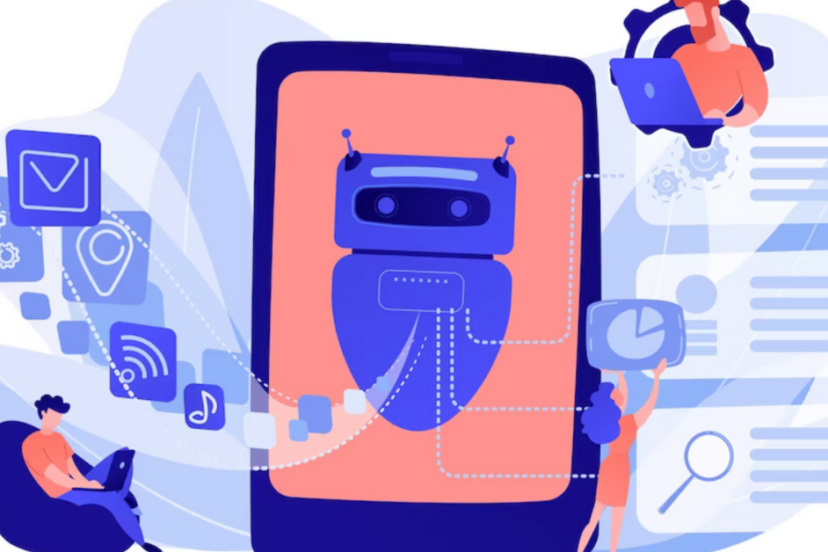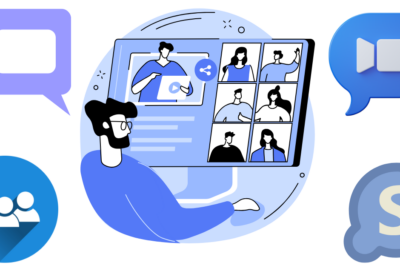How Chatbot Development Platforms Revolutionize Customer Experience
Consider accessing a website or app and seeing an intelligent chatbot instead of a problematic menu or a human customer support representative. It listens and answers in a timely and accurate manner. Many companies already function in this manner. Chatbot development platforms have revolutionized the client experience, enabling this innovation.
This article investigates this disruptive technology and popular platforms like Dialogflow, IBM Watson Assistant, and the Microsoft Bot Framework. Investigate how these platforms allow chatbots to improve customer care and transform the consumer experience.
Let’s delve into the world of chatbots and examine the platforms used to create them.
Understanding Chatbots
Chatbots employ AI and NLP to comprehend and communicate with humans. It replicates and processes human dialogue, allowing people to connect with digital gadgets like they would with a person.
Websites, smartphone apps, and messaging systems like WhatsApp, Facebook Messenger, and Slack can host chatbots. They are designed to automate tasks typically handled by humans, making services more efficient.
Importance of Chatbots
In the digital age, chatbots have become a crucial tool for businesses across all industries. They’ve altered how organizations engage with their customers, offering many advantages that improve the customer experience and operational efficiency. Let’s look at why chatbots have grown so popular.
1. 24/7 Customer Service:
Customers expect instant responses at any hour in our global, always-on world. Chatbots are tireless, working around the clock to answer customer queries immediately. This ensures customers get the help they need whenever needed, leading to higher customer satisfaction.
2. Reduced Operational Costs:
Traditional customer service channels can be costly and resource-intensive. Conversely, chatbots assist organizations in automating repetitive operations, allowing human agents to focus on more challenging problems. This not only reduces operational costs but also improves service efficiency.
3. Scalability:
As your business grows, so too does the volume of customer queries. Chatbots can handle many customers simultaneously, allowing your business to scale its customer service efforts without a corresponding increase in staff.
4. Personalized User Experience:
Leveraging AI and machine learning, chatbots can provide personalized experiences to customers. They can analyze user behavior and preferences to offer tailored responses, recommendations, and promotions, enhancing the customer experience and fostering loyalty.
5. Insightful Customer Analytics:
Customer interactions can be collected and analyzed via chatbots, giving significant insights into client behavior, needs, and expectations. These insights can inform business strategies, improve products and services, and drive growth.
6. Better Engagement:
Chatbots improve customer engagement by offering instant, consistent, and accurate responses. They make interactions easy and convenient, increasing customer satisfaction and loyalty.
7. Multilingual Support:
With the ability to understand and converse in multiple languages, chatbots can communicate with customers worldwide in their native language. This breaks down language barriers and opens up global markets for businesses.
Chatbot Development Platforms and Their Features
These development platforms provide a foundation for building and deploying chatbots. They offer features like natural language processing (NLP), user intent recognition, and integration capabilities with other platforms. Let’s explore each of them in detail.
A. Dialogflow
Google-powered Dialogflow, formerly known as API.AI, is a well-liked chatbot development platform. It is used to build conversational user interfaces for websites, mobile applications, popular messaging platforms, and IoT devices. Dialogflow leverages Google’s robust machine learning and natural language understanding capabilities to comprehend user intent and deliver relevant responses. It’s designed to understand the context of a conversation, ensuring natural, human-like interactions.
Features of Dialogflow
Natural Language Understanding:
Dialogflow excels in understanding and processing natural languages. It can parse various types of user input, like text or voice, understand the intent behind the input, and respond contextually appropriately.
Integration:
Dialogflow can easily be integrated with various popular platforms like Google Assistant, Facebook Messenger, Slack, and Twitter. This makes it highly versatile, enabling businesses to reach their customers wherever they are.
Multilingual Support:
With support for over 20 languages, Dialogflow can help businesses communicate with customers worldwide in their preferred language.
Pre-Built Agents:
Dialogflow provides pre-built agents for several domains, which might be a good starting point for many enterprises. These agents have pre-defined intents and entities, speeding up the development process.
Voice Recognition:
Leveraging Google’s advanced voice recognition, Dialogflow can effectively process voice inputs. This makes it ideal for creating voice-based virtual assistants or integrating voice-enabled devices.
Machine Learning:
Dialogflow leverages Google’s machine-learning capabilities to train its models. Over time, the chatbot becomes better at understanding user intent and delivering accurate responses, leading to more effective interactions.
Contextual Conversations:
Dialogflow keeps track of the context in conversations. This means it can understand references made to previous queries or responses, enabling more natural and engaging conversations.
B. IBM Watson Assistant
IBM Watson Assistant is a highly robust chatbot development platform that forms part of IBM’s suite of AI services. It is designed for enterprise purposes, offering a safe and scalable solution for building, training, and deploying conversational interfaces into any application, device, or channel. IBM Watson Assistant brings the power of sophisticated AI and machine learning algorithms to businesses, aiding in creating intuitive, context-aware chatbots.
Features of IBM Watson Assistant
Intuitive UI:
Watson Assistant provides a user-friendly interface that allows developers to build conversational flows and train the assistant, even if they need to become expert coders. The visual dialog editor makes the design and testing process easy and intuitive.
Contextual Understanding:
Watson Assistant can comprehend the context and nuances of a discussion using advanced machine learning techniques, making interactions with people natural and engaging.
Multi-Channel Availability:
IBM Watson Assistant can be integrated with various platforms, including mobile apps, web applications, and popular messaging platforms like Slack and Facebook Messenger, ensuring a seamless experience across channels.
Enterprise-Grade Security:
Given IBM’s deep-rooted focus on enterprise needs, Watson Assistant is designed to meet high-security standards. It ensures that the data remains safe and the users’ privacy is maintained.
Analytics and Insights:
Watson Assistant provides powerful analytics that can offer insights into how the chatbot is performing, how users interact, and what improvements can be made. This helps businesses optimize their chatbots over time.
Pre-Built Content:
Watson Assistant offers pre-built content for several industries like banking, insurance, retail, and more. This accelerates the bot-building process and ensures the chatbot aligns with industry-specific needs.
C. Microsoft Bot Framework
Microsoft Bot Framework is a comprehensive offering in the field of chatbot development platforms. As part of Microsoft’s Azure services, it provides the tools necessary to build, connect, test, and deploy intelligent, interactive chatbots. The platform has been designed to focus on robustness, scalability, and the ability to integrate with various services.
Features of Microsoft Bot Framework
Multi-Language Support:
Microsoft Bot Framework supports development in multiple programming languages, including C#, JavaScript, and Python, providing flexibility to developers.
Rich Dialog System:
The framework offers a rich dialog system that supports complex multi-turn conversations, enabling the creation of interactive and engaging chatbots.
Integration Capabilities:
With Microsoft Bot Framework, you can connect your bot to popular channels such as Microsoft Teams, Skype, Slack, Facebook Messenger, and email.
Adaptive Cards:
One of the standout features of the Microsoft Bot Framework is the support for adaptive cards. These interactive cards can contain various inputs and actions, enhancing the interactivity of the bot and improving the overall user experience.
Azure Bot Service:
As part of Azure services, the Bot Framework integrates seamlessly with Azure Bot Service, a managed bot service that scales on demand, offering a serverless bot development experience.
In-built Testing and Debugging Tool:
The Bot Framework Emulator is an application on a desktop that allows developers to test and debug their bots locally, making bot development easier.
LUIS Integration:
Microsoft Bot Framework can be integrated with Language Understanding Intelligent Service (LUIS), a machine learning-based service for building natural language experiences. This allows for an improved understanding of user intent and more nuanced responses.
Considerations for Choosing the Right Platform
With these great options, choosing the right chatbot development platform can seem daunting. So, what should you consider? Remember, the choice depends on your unique business needs and resources.
Ease of Use:
Consider the learning curve associated with each platform. If your team needs more technical expertise, you’ll want to choose a user-friendly platform that doesn’t require extensive coding knowledge.
Integration Capabilities:
If you want to integrate the chatbot with your business’s existing systems or platforms, ensure the platform supports such integrations.
Scalability:
As your business grows, so will your customer interactions. You need a platform that can scale your business and handle increased traffic and queries without compromising performance.
Customization:
If you need your chatbot to perform specific tasks or functions unique to your business, choose a platform that allows for high levels of customization.
Natural Language Processing (NLP):
Choose a platform with advanced NLP capabilities for more sophisticated, conversational chatbots.
Security:
If your chatbot handles sensitive information, security should be a top consideration. Choose a platform known for its robust security measures.
Pricing:
Pricing models can vary greatly among platforms. Some offer a free version with limited features or a pay-as-you-go model, while others might charge a monthly or annual fee. Consider your budget and the platform’s pricing model to ensure it’s cost-effective for your business.
Support and Maintenance:
Look for platforms that provide strong technical support and regular updates to ensure your chatbot remains bug-free and up-to-date with the latest features.
The chatbot development platform you choose can affect its performance. After careful investigation, choose the platform that fits your business’s demands and goals.
Conclusion
AI and chatbots have shown how Dialogflow, IBM Watson Assistant, and the Microsoft Bot Framework transform customer interactions. These systems simplify chatbot development, improving customer satisfaction. With simple interfaces and user-friendly toolkits, non-technical users may build highly functional and interactive chatbots.
AI-dominated futures will require chatbot development platforms. Businesses that use these platforms will transform customer experiences. Select a system that fits your requirements and available resources. Every excellent customer experience starts with a company that cares about its customers.
FAQs
What are chatbot development platforms’ main features? Chatbot development platforms enable NLP, user intent recognition, and channel connectivity. Each platform offers unique qualities.
Chatbots benefit which industries? Chatbots can help almost every area, including retail, healthcare, banking, tourism, and education.
What should I look for in a chatbot development platform? Consider simplicity of use, learning curve, cost, scalability, integration, and your business’s needs.
Can chatbots understand multiple languages? Many chatbot development platforms, like Dialogflow, offer multilingual capabilities, allowing chatbots to interact with users in various languages.
Can chatbots be used for internal business processes? Chatbots can be used for internal processes like IT support, HR queries, and data retrieval.





Comments are closed.